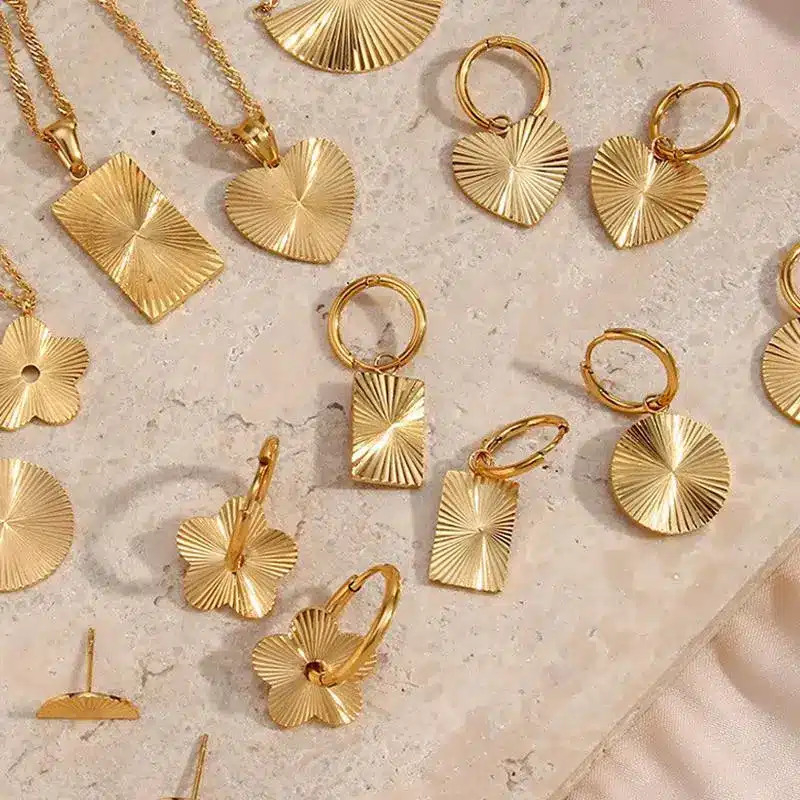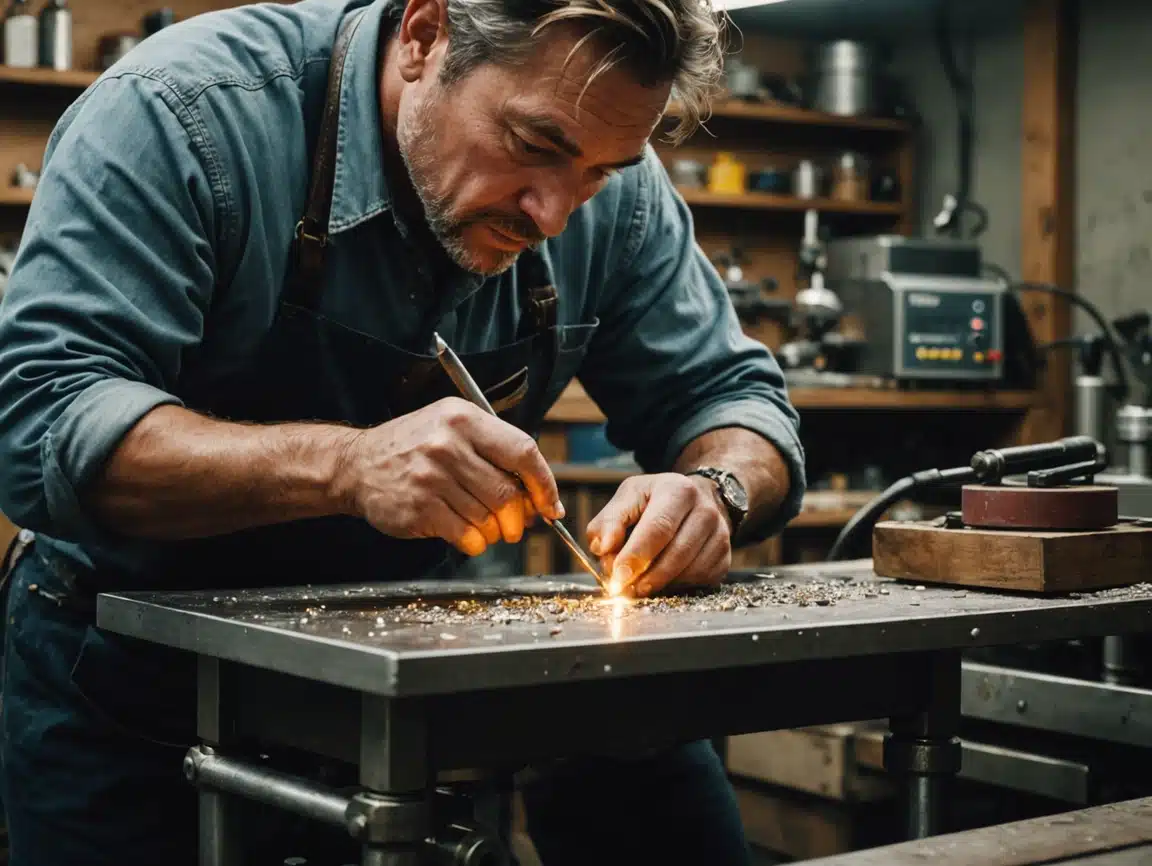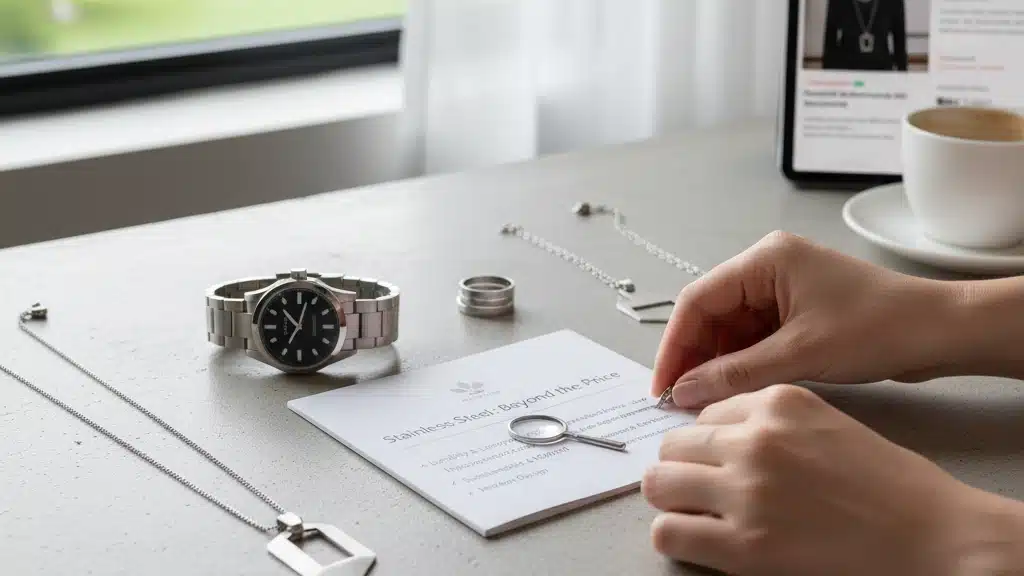Custom jewelry | Create your unique piece today

Key Takeaways
- Idea conception, design collaboration, three-dimensional modeling, meticulous production, and thoughtful finishing – that’s how the custom jewelry magic happens.
- Transparent communication and a collaborative relationship with a trusted maker ensure you get a piece that reflects your individual vision without compromising on quality or ethics.
- Materials like metals and gemstones, as well as design complexity and artisan skill level, are the principal factors that affect the ultimate price of custom jewelry.
- Choosing ethically sourced, sustainable materials backs good practices and makes custom creations even more valuable.
- Jewelry companies that offer aftercare, such as routine maintenance and repair services, help retain the shine and wearability of custom pieces long-term.
- Custom jewelry combines the power of personalization, heirloom quality and emotional depth, transcending a world of mass-market accessories.
Companies that make custom jewelry provide options for individuals to design unique items tailored to their personal tastes and requirements. A lot of brands use artisan craftsmen and allow customers to select the materials. They accommodate a wide range of prices.
Some specialize in fine metals and stones, while others leverage new tech such as 3D printing to enable more options. To assist you in finding the perfect match, the main section will display leading choices and what distinguishes each.
The custom jewelry process
Custom jewelry is defined by distinct milestones, from concept to completion. Each step is molded through tight collaboration among the client, designer, and craftsmen. For most companies, they keep you in the loop throughout, so it’s open and smooth. The timeline for a project is anywhere from four to ten weeks, though there is a rush option for expedited turnaround.
Below are the main steps in the custom jewelry process:
- Brainstorm and define the concept
- Work with designers to develop the design
- Use CAD tools to create a 3D model
- Select materials and begin crafting
- Apply finishing touches and prepare for delivery
1. The idea
A custom jewelry project begins with a simple conversation. Clients tend to come in with inspiration from special life events — an engagement, family heritage, a vacation. These anecdotes spur the initial idea.
Using symbols or shapes or colors that are meaningful makes it feel personal. Thinking about who is going to wear the piece is key. If it’s a gift, the giver might consider the recipient’s preferred colors, aesthetics or themes.
Sketches, notes, or even pictures can help keep ideas clear. This rough road map serves as a beacon for the subsequent steps.
2. The design
Once the concept is firm, customers sit down with a designer to transform concepts into actual designs. Our designers digitally rendered to demonstrate what the jewelry could look like in complete detail.
This provides us both with a vivid picture before any of it gets produced. Feedback is in the mix. The client can request modifications, large or small. The designer may propose adjustments to assist comfort or longevity.
When they’re all in agreement, the design is locked in–typically with an approved sketch or CAD rendering. Communication remains solid here. They update customers frequently, so there aren’t any surprises.
3. The model
Next, a 3D model. They construct a precise digital replica of the piece using CAD software. This step aids in catching issues early and gives you a chance to tweak before manufacturing.
Other jewelers print a plastic or wax prototype with a 3D printer. This allows the customer to hold and visualize the model, verify the size and stone placement. There’s still time to make adjustments at this stage — which reduces risk and saves time down the road.
4. The creation
Once the model is approved, experienced goldsmiths begin to create. They select the appropriate metals, stones and components as specified in the design.
We employ hand tools and state of the art machines in order to achieve exacting results. Quality checks occur at every step. Materials and methods information is recorded by the crew.
If gemstones are involved, a gemologist might assist you in selecting the perfect one. Each step here is about fulfilling the design we agreed on and the standards.
5. The finish
Finishing is polish and love. Makers buff and polish every component, occasionally plating for that additional gleam. The final piece is checked for flaws.
Secure packaging protects the jewelry in transit. Care tips are shared to maintain the piece’s appearance.
Choosing your creative partner

Choosing that special custom jewelry company is about more than just appearances; it involves evaluating their jewelry manufacturing services, craftsmanship, and ability to bring your vision to life. The most amazing creative partners are the ones who lead you from initial scribble to final polish, tailoring every step along the way to create unique designs that tell your narrative.
Craftsmanship
Expert hands transform metal and jewels into art. Seek out brands that have years of creating bespoke pieces, not with gold or platinum alone, but silver and other metals that suit various lifestyles. Good makers will exhibit a transparent portfolio, with close-ups that allow you to inspect the finish and how securely stones sit.
Others emphasize work with exotic stones or unique cuts—such as a three-stone ring where each gem commemorates a life event. The materials are just as important as the design. Inquire about their gems—resilient sapphires or hard lab-created diamonds. See if they utilize recycled gold or traceable metals.
Quality means more than shine–it means your ring or pendant lasts for years, withstands daily wear and tear, and survives future repairs. Some reputable firms will support their work with a warranty or complimentary annual check-ups, providing reassurance.
Collaboration
Straight talk is essential from the beginning. The good companies arrange get togethers–virtual or IRL–to listen to your concepts, demonstrate design and ship status as your article comes together. They’ll allow you adjust details, replace a stone, or change the metal if your requirements change.
Feedback loops assist. Some makers employ 3D mockups or wax models so you can experience the shape before it’s cast. This aids both parties to address issues early. A quality partner treats you like a team member, not just a client.
They’ll establish reasonable deadlines, divide the work into stages, and visit at every one. This keeps your project flowing and keeps everyone in sync.
Ethics
Ethics are compulsory! Select brands that carefully source gems, comply with fair labor laws and seek to eliminate waste. Inquire if they utilize recycled silver, promote fair-trade gold, or collaborate with mines that contribute to the local workforce.
Seek validation—awards or transparent policies on their site. Brands that disclose their supply chain information demonstrate they prioritize transparency and like to keep you cozy about your little gem. It counts if you want your jewelry to align with your ethics as well as your style.
Aftercare
Request maintenance tips—how to clean, when to check settings, what to steer clear of. See if the company provides any repairs or maintenance, such as stone tightening or repolishing.
Aftercare checklist:
- Keep your jewelry in a soft pouch, protected from light.
- Wipe with a soft cloth and mild soap, not caustic cleaners.
- Examine clasps and settings every couple of months or after hard knocks.
- Take off your jewelry before swimming or heavy work.
- Set up routine check-ups with your maker for peace of mind.
A few makers have loyalty programs, rewarding discounts or perks for cleaning or subsequent purchases.
What influences the cost
The cost of custom jewelry is influenced by a combination of materials, the complexity of the design, and the craftsperson’s experience in jewelry manufacturing services. Each choice impacts the ultimate cost, making unique designs not only special in appearance but also in price.
Materials
Material selection sets the floor price. Gold, silver and platinum are the most common metals, each having a different price. Platinum is more expensive than gold or silver because it’s rarer and stronger. Assuming you pick gold, the cost then depends on the karat, with 24k being the highest and most costly.
Gemstones can make a huge difference as well. Natural diamonds, sapphires and emeralds are between $50 and $20,000 per carat, depending on quality. The 4Cs — cut, color, clarity, and carat weight — determine a diamond’s cost. Artificial ones cost less and can appear nearly as good as the real thing. Recycled metals and stones reduce the price but provide a more eco-friendly alternative.
|
Material Type |
Characteristics |
Effect on Cost |
|---|---|---|
|
Gold |
Soft, yellow or white, various karats |
Varies by purity |
|
Platinum |
Dense, durable, rare |
High |
|
Silver |
Malleable, bright, prone to tarnish |
Lower than gold |
|
Diamonds |
Priced by 4Cs, natural or synthetic |
Wide price range |
|
Sapphires |
Blue or colored, natural or lab-grown |
Mid to high |
|
Recycled Metal |
Eco-friendly, same quality as new |
Lower cost |
Complexity
Basic bands or pendants are less expensive than items with intricate filigree or extensive stone settings. If a design has a lot of small components or engraving, it requires more labor. That can double or even triple production timelines.
If you desire an engraving of your own or a morph design, prepare to shell out extra cash. Larger or more intricate works require greater effort and expertise, thus the cost goes up. Optimizing the design or selecting less custom features can reduce the charge.
Craftsmanship
The expertise of the jeweler counts as much as the scratch resistance of the materials. Master jewelers with a few decades under their belts tend to command a premium. They employ techniques that contribute to quality and finish, such as hand-polishing or micro-setting stones.
Handmade jewelry is generally more expensive than machined pieces. It’s time spent forming and molding and finishing each piece that really accumulates. Amazing workmanship might imply the piece is worth hanging on to, or even resell for more, down the line.
Other cost drivers
Where the jeweler is located plays into labor rates and overhead. Local market trends can drive prices up or down. Labor fees increase with the cost of living in big cities.
A 2-carat diamond is worth A LOT more than a smaller one.
The materials palette

Materials decisions direct the style, texture, and morality of custom jewelry manufacturing services. Brands employ everything from traditional metals and gemstones to more inventive choices, ensuring unique designs that appeal to buyers who desire durability and ethical sourcing.
Metals
Gold is timelessly elegant, but it’s not a one-style-fits-all thing. Solid gold is valued for its durability and tone, whereas gold-filled or plated pieces are less expensive but can erode over time. Silver is lighter and gleam bright, but can tarnish.
Metals such as titanium and stainless steel have become standard, prized for durability and minimal risk of skin irritation. Metals vary by weight, color and cost. Here’s a quick look:
|
Metal |
Weight |
Color |
Cost |
Hypoallergenic |
|---|---|---|---|---|
|
Gold (solid) |
Medium-High |
Yellow, white, rose |
High |
Yes |
|
Silver |
Light |
Bright white |
Moderate |
Sometimes |
|
Titanium |
Very light |
Grey |
Low |
Yes |
|
Stainless |
Medium |
Silver-grey |
Low |
Yes |
Gemstones
The options of gems are endless. Diamonds, sapphires, and emeralds are all hot picks, each with their own aesthetic and narrative. Gemstone value is a function of cut, clarity, color, and carat weight.
Fine cutting and clear stones tend to be pricier. Lab-grown diamonds and gemstones are increasing in popularity because they provide the same sparkle, but with a reduced environmental footprint. Ethically sourced stones provide a peace of mind that no destruction occurs while mining.
Personal touches come from the stone you select. Birthstones, favorite colors or family stones infuse deep meaning. Much of what buyers want these days is a stone with a clear supply chain – ethics that are just as key as beauty.
Alternatives
Others in the custom jewelry space opt for recycled metals or lab-created stones in an effort to reduce waste and conserve resources. Innovative materials such as wood or resin find a place in contemporary designs, adding exclusivity to the pieces.
These picks can be easier on the wallet, but don’t compromise on style or function. Some examples include:
- Recycled gold and silver
- Lab-grown diamonds
- Synthetic gems (cubic zirconia, moissanite)
- Wood, resin, or acrylic
- Ceramic, glass, and enamel
Packaging and Presentation
Luxury trays utilize velvet, suede, or Alcantara for a plush feel and luxurious appearance. Other trays employ wood, cardboard, or paper for a more rustic or minimalist design.
Packaging materials such as leatherette, plastic and fabric can complement a brand’s aesthetic. Green and recycled packaging are par for the course these days to reduce waste. The selected material frames the experience and safeguards the jewelry within.
Why custom is invaluable

Custom jewelry provides folks with an outlet to express themselves. Every item can fit a person’s preference, whether that be the shape or color, or the metal or stone type. It’s not just another store-display ring or necklace. Say, they want a pendant birthstone or a ring that fits – just. That kind of selection allows customers to sport an item that really resonates as their own.
There’s usually more to a custom piece than appearance. It can be a present for a grand occasion, like an engagement, wedding, or birthday. It can be personalized to commemorate a person or a moment. For a lot of people, these items are more than just objects—they’re heirlooms. They are handed down from relative to relative, gaining in worth with every generation, particularly when crafted through custom jewelry manufacturing services.
Think of a custom locket with a family crest or a bracelet with an engraved message; they can tell tales for years to come. Unlike mass-made jewelry, custom pieces shine. You never run the risk of running into someone else with the same! This exclusivity is what makes every piece feel special and highlights the quality custom jewelry that artisans create.
A lot of people just like the idea that their jewelry is custom, helping them stand out in a crowd of wannabes. With custom jewelry services, you can add those little important details that reflect the wearer, like initials or symbols, or even a custom stone cut. That’s what makes custom so special and personal.
Makers employ fine materials and can afford to spend time at every stage, from conception to final coat. This attention to detail ensures the end product is both gorgeous and enduring. A quality custom ring or necklace will appear new for decades, even if worn every day. A good jeweler, for example, might employ platinum, gold, or rare gemstones, and check each setting and clasp for integrity during the jewelry manufacturing services process.
There’s something about being involved in the design that makes it extra special. You can collaborate with jewelers to select materials, forms, and finishes. This collaborative effort is what makes the creation enjoyable and satisfying. The final product is a piece that genuinely seems like part of the owner’s tale, showcasing the unique designs that custom jewelers can offer.
Custom jewelry additionally provides a superior fit, where pieces can be formed to the wearer’s specifications, for example, ring size or pendant length. Because when you buy custom, you frequently are purchasing a piece that becomes both personal and timelessly valuable. These aren’t just one and done—they last for years, get gifted, and handed down, solidifying their place in the jewelry industry.
The future of personal adornment

Personal adornment is evolving rapidly. Custom jewelry companies are at the forefront of this change by fusing new technology, ethical considerations and striking design. With more consumers wanting pieces that reflect their identity, the industry is shifting to accommodate these desires.
Digital tools now allow anyone to craft their own jewelry. For many brands, this means using 3D models or online platforms, where purchasers swap stones, metals, and shapes prior to production. This tech accelerates the design process and enables customers to visualize and customize their selections in real-time.
Smart jewelry is making inroads. Makers are now embedding tiny chips or sensors into products, so rings or bracelets do more than look stylish—they monitor health or sync with smartphones.
Sustainability is jewelry making’s new center. About two-thirds of shoppers seek out sustainability in what they buy and it’s changing the way brands operate. Most companies at this point use recycled metals or lab-made gems, reducing mining and waste.
A few brands provide verifiable evidence of their supply chain, so consumers can be assured their item was crafted with respect for individuals and the environment. Ethical practices are not a fad—they’re the future. This transition arrives as consumers desire not only aesthetic attractiveness, but tranquility with what they sport on.
The shift to individual fashion is powerful. Some 45% of consumers seek out jewelry that reflects their authentic identity. Custom jewelry allows this, enabling individuals to select motifs, hues, or designs that resonate with them.
The layering trend is not going anywhere. They blend metals, textures, or ethnic motifs, creating looks that are uniquely them. No longer is one style considered superior. Rather, there is the freedom to experiment with either bold, chunky pieces or more subtle stacked rings and chains.
Maximalism is back, with more buyers attracted to attention-grabbing shapes and sizes. Designers today pull from a world-wide well of inspiration. Cross-cultural influences define new lines as labels eye motifs, narratives and techniques from multiple traditions.
These inject new vitality into traditional styles and assist consumers in selecting items that resonate with their heritage or principles. New materials and new methods of making jewelry just keep appearing.
Lab-grown gems, recycled gold, and even plant-based resins provide options for the alternative wearer. These alternatives allow consumers to select items that align with their values and taste without sacrificing excellence or aesthetics.
Conclusion
Custom jewelry is special for its combination of craftsmanship and narrative. Makers bend gold, silver, gems and more, molding every piece to be uniquely you. Prices will vary with the design, metal and stones, but the finished piece always feels unique. Good partners walk you through every step and show you samples, so you know what to expect. More people want pieces that say something real about them, not just what’s in stores. To find out more about a maker or kick off your own piece, browse their online galleries or send them a message for info. A lot provide free chats or sketches, so that part’s easy. Check it out and find what works for you.
Frequently Asked Questions
How do companies create custom jewelry?
They begin with your inspiration, utilizing custom jewelry manufacturing services to draft design sketches, choose materials, and fashion the finished product. Transparent communication guarantees that your vision is realized.
What should I look for in a custom jewelry company?
Seek out experienced jewelry makers with an impressive portfolio, transparent communication, and testimonials. A good company will guide you through each step of the custom jewelry manufacturing services and guarantee the workmanship.
What factors affect the cost of custom jewelry?
Price varies based on materials, design intricacy, and craftsmanship, particularly in custom jewelry manufacturing services where specialist metals or unique designs can significantly boost the cost.
Which materials are most popular for custom jewelry?
Popular options include gold, platinum, silver, and an array of gemstones, while some companies offer custom jewelry manufacturing services that utilize sustainable or recycled materials, allowing you to truly tailor your unique designs.
Why is custom jewelry valuable?
Custom jewelry manufacturing services provide a personalized look that mass production just can’t match, reflecting your style and story.
How long does it take to make custom jewelry?
It typically takes anywhere from two to six weeks for custom jewelry manufacturing services, depending on design complexity, material availability, and company busyness.
Can I use my own materials or gemstones?
Several companies offer personalized jewelry production, allowing you to provide your own metals or stones. This alternative not only adds meaning but also occasionally saves money, so discuss this option early.
Related Posts

Understanding Wholesale Jewelry Pricing and How It Works
Understanding Wholesale Jewelry Pricing and How It Works When people see a ring that costs $6 wholesale and retails for $59, they often

The Art of Shine in Jewelry Polishing and Plating Techniques
Discover how polishing and plating transform modern jewelry with expert techniques for lasting shine and elegant finishes.

Τι Νοιάζει Πραγματικά τους Αγοραστές Ανοξείδωτου Κοσμήματος Εκτός από την Τιμή
Τι πραγματικά νοιάζει τους αγοραστές ατσάλινων κοσμημάτων πέρα από την τιμή ανθεκτικότητα υποαλλεργικά υλικά και μοντέρνο στυλ.
